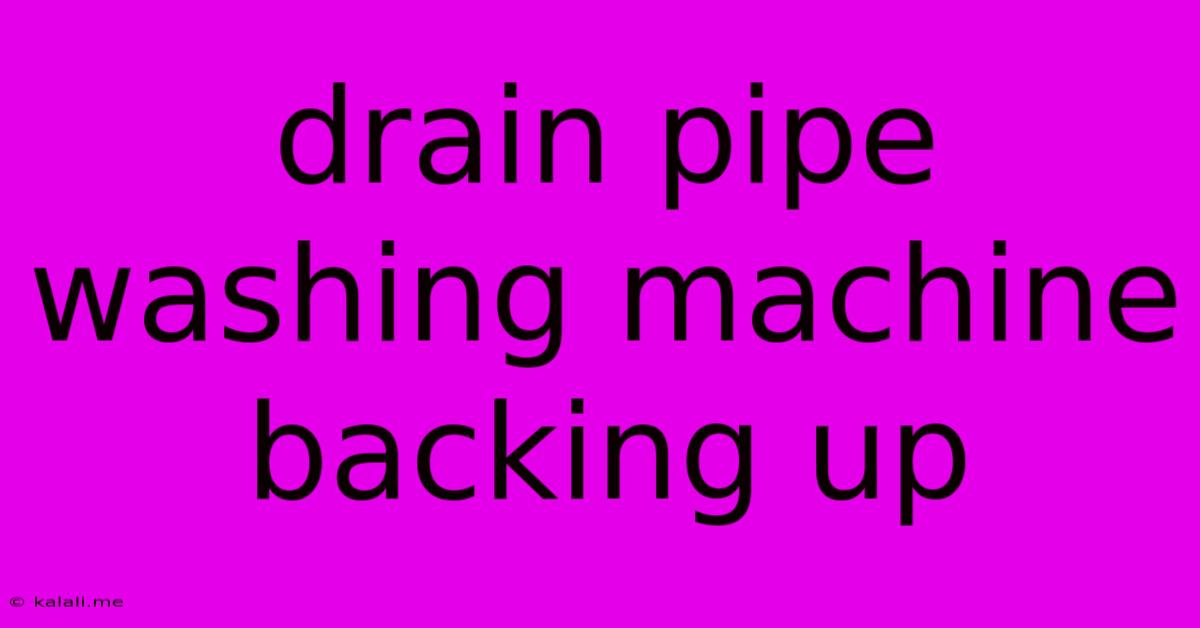Drain Pipe Washing Machine Backing Up
Kalali
Jun 04, 2025 · 3 min read

Table of Contents
Drain Pipe Washing Machine Backing Up: Troubleshooting and Solutions
A backed-up washing machine drain pipe is a frustrating plumbing problem, often leading to a soggy laundry room and a halt in your laundry routine. This article will guide you through identifying the causes, troubleshooting the issue, and implementing effective solutions to get your washing machine draining properly again. We'll cover everything from simple DIY fixes to when you might need to call a plumber.
Understanding the Problem:
A washing machine drain pipe backup occurs when wastewater can't flow freely from the machine to the main drain line. This can manifest in various ways, including slow draining, complete blockage, or even water overflowing from the machine. The culprit is usually a clog somewhere along the drain line, but other factors can contribute.
Common Causes of Clogs:
- Lint and Fabric: Small pieces of lint, fabric, and fibers from clothing can accumulate over time, gradually restricting water flow. This is especially common with older machines or those that haven't had regular maintenance.
- Hair: Hair, particularly pet hair, can clump together and create significant blockages in the drain pipe.
- Soap Scum and Detergent Buildup: Excessive detergent or hard water can lead to soap scum buildup, reducing the pipe's diameter and hindering drainage.
- Foreign Objects: Buttons, coins, or other small items accidentally dropped into the washing machine can obstruct the drain pipe.
- Pipe Damage or Blockage: A collapsed or damaged drain pipe, perhaps due to age or corrosion, can cause significant drainage problems. Tree roots invading the sewer line can also be a major issue.
- Incorrect Installation: Improperly installed drain pipes can lead to kinks, bends, or low points where water stagnates and clogs form.
Troubleshooting Steps:
Before attempting any major repairs, try these troubleshooting steps:
- Check the Drain Hose: Inspect the washing machine drain hose for kinks, bends, or clogs. Remove the hose, carefully examine it, and clear out any debris. Make sure it's properly connected to both the machine and the drainpipe.
- Examine the Drain Pipe: If the hose is clear, investigate the drainpipe itself. Look for obvious obstructions or signs of damage. A flashlight can help illuminate the inside of the pipe.
- Use a Plunger: Try using a cup plunger on the drain opening to dislodge any clogs. Ensure there is enough water in the drainpipe to create a seal.
- Try a Drain Snake (Auger): For more stubborn clogs, a flexible drain snake (also known as an auger) can be used to reach further into the pipe and break up or retrieve the blockage. This is often effective in removing hair or lint buildup.
- Check the Standpipe: The standpipe is the vertical pipe that the drain hose connects to. Ensure it's not clogged or obstructed.
Solutions and Preventative Measures:
- Regular Cleaning: Regularly clean the washing machine's lint filter and avoid overloading the machine to minimize lint and fabric buildup.
- Proper Detergent Usage: Use the recommended amount of detergent and consider using a detergent specifically designed for hard water if necessary.
- Preventative Maintenance: Periodically check the drain hose and drainpipe for any signs of clogs or damage. Consider using a drain cleaner (use cautiously and according to the instructions) to prevent future buildups.
- Professional Help: If you've tried all the troubleshooting steps and the problem persists, it's time to call a licensed plumber. They have the tools and expertise to diagnose and fix more complex issues, such as pipe damage or sewer line problems.
By understanding the common causes and following these troubleshooting steps, you can often resolve a washing machine drain pipe backup yourself. However, don't hesitate to seek professional help if the problem persists or if you're unsure about tackling the issue on your own. Remember, preventative maintenance is key to avoiding this frustrating plumbing problem in the future.
Latest Posts
Latest Posts
-
How Long Does It Take To Get An Alignment
Jun 06, 2025
-
They Broke The Covenant When I Made It Through
Jun 06, 2025
-
How To Stop Getting Recommended A Certain Topic On Youtube
Jun 06, 2025
-
How To Get Rid Of Bugs On Indoor Plants Soil
Jun 06, 2025
-
Can You Eat Duck Medium Rare
Jun 06, 2025
Related Post
Thank you for visiting our website which covers about Drain Pipe Washing Machine Backing Up . We hope the information provided has been useful to you. Feel free to contact us if you have any questions or need further assistance. See you next time and don't miss to bookmark.